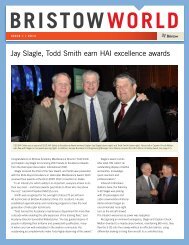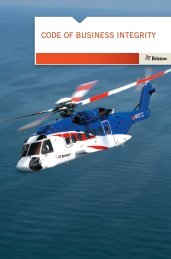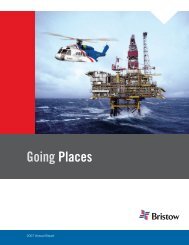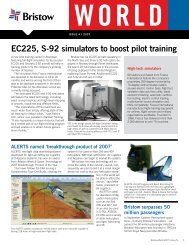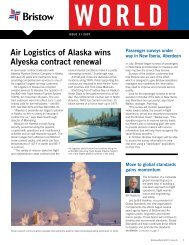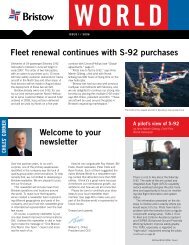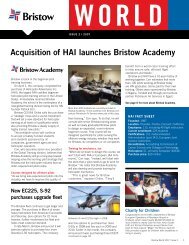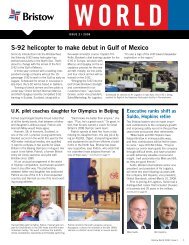Bristow Group The Secrets of Success, Vertical News VOL.8 No.1
Bristow Group The Secrets of Success, Vertical News VOL.8 No.1
Bristow Group The Secrets of Success, Vertical News VOL.8 No.1
Create successful ePaper yourself
Turn your PDF publications into a flip-book with our unique Google optimized e-Paper software.
Reprint <strong>of</strong> VOL. 8 No. 1<strong>Bristow</strong> <strong>Group</strong><strong>The</strong> secrets <strong>of</strong> success<strong>Bristow</strong> 1
2 verticalmag.com2 verticalmag.comDownload as wallpaper at verticalmag.com/photos
<strong>The</strong> <strong>Secrets</strong><strong>of</strong> successCombining growth, expansionand acquisition with a focuson quality service has led<strong>Bristow</strong> up the food chain in the<strong>of</strong>fshore oil and gas sector.Story by Jeffrey DeckerPhotos by Graham Lavery, Heath M<strong>of</strong>fatt and Mike Reyno<strong>Bristow</strong> 3 <strong>Bristow</strong> 3
Each solemn morning over the world’s oceans, a familiar scenerepeats itself: fresh sunlight creeps into the dark cabin <strong>of</strong> a heavyhelicopter, heralding the first day <strong>of</strong> work for the passengerswithin. It’s two weeks at sea for this bunch, back on the chasefor oil in the <strong>of</strong>fshore fields. <strong>The</strong>y’re among the thousands <strong>of</strong>workers who routinely say goodbye to their families to strap intoa life vest and fly out to the oil platforms where there’s money tobe made.Industry-wide, ferrying workers from land to more than 8,000<strong>of</strong>fshore oil and natural gas platforms and rigs is a job foraround 1,500 helicopters — about 500 <strong>of</strong> them fly underthe <strong>Bristow</strong> <strong>Group</strong> banner. With operations in 21countries and more than 3,600 employees, <strong>Bristow</strong>is, by many standards, the world’s largest commercialhelicopter operator. While it takes ona host <strong>of</strong> other duties, its primary mission isstraightforward: <strong>Bristow</strong> is an immense andsophisticated shuttle service.Pieces <strong>of</strong> the Puzzle<strong>Bristow</strong>’s worldwide presence stems from aseries <strong>of</strong> mergers and acquisitions that hasn’tstopped yet. Even today, it is a growing concern,steadily absorbing other companies while strivingfor uniformity across cultures. “When I came here in2004, we set an objective to double the size <strong>of</strong> the companyin five years,” said chief executive <strong>of</strong>ficer and president WilliamE. Chiles. From 2007 to 2008, <strong>Bristow</strong> doubled capital expensesand saw net income jump more than 40 percent.4 verticalmag.com
Download as wallpaper at verticalmag.com/photosOpposite Left Where <strong>Bristow</strong> derivesits revenues from.Opposite right In addition to <strong>of</strong>fshoreand onshore oil and gas explorationprojects in Alaska, <strong>Bristow</strong> is alsosupporting pipeline operations there.right With a fleet <strong>of</strong> seven mediumand 13 heavy helicopters, <strong>Bristow</strong> is thelargest <strong>of</strong>fshore helicopter providerin Australia.Far right <strong>Bristow</strong> currently operates afleet <strong>of</strong> 38 heavy helicopters in the NorthSea, supporting <strong>of</strong>fshore oil andgas operations.top right <strong>Bristow</strong> <strong>Group</strong> operates in21 countries around the world.above Since its introduction intothe <strong>Bristow</strong> fleet in 2007, the S-92worked exclusively in the North Sea.In the summer <strong>of</strong> 2008, though, it wasintroduced into the Gulf <strong>of</strong> Mexico.<strong>Bristow</strong> 5
hours <strong>of</strong> <strong>of</strong>fshore flying. Through education, co-operation andfrequent communication, that safety-focused corporate culture isbreathed into each pilot, each support team and each hangar.<strong>Bristow</strong> has been involved in search and rescue (SAR) operations for over 35 years in one shape or another. Several <strong>of</strong> it'saircraft have a secondary SAR response.<strong>Bristow</strong> Helicopters Ltd. was founded in 1955; it was acquiredby Offshore Logistics in 1996. Because <strong>of</strong> its international namerecognition, the “<strong>Bristow</strong>” brand stuck, although the companycontinues to operate as Air Logistics, a <strong>Bristow</strong> Company, in theU.S.. In recent years, the company has moved into flight training,which it sees as a way to breed that desired uniformity acrossoperations. It began when <strong>Bristow</strong> acquired the Florida-basedHelicopter Adventures Inc. — now <strong>Bristow</strong> Academy — in 2007.Other schools followed shortly thereafter. An English flight academyis its most recent training acquisition.In October, <strong>Bristow</strong> saw its partial ownership in NorskHelikopter in Norway grow to complete ownership. Now, this newmember <strong>of</strong> the big family can pass on its innovative documentmanagement system, which interfaces with aircraft maintenancesystems. (But, while <strong>Bristow</strong> approaches the North Sea fromall angles, it won’t be mingling resources until one <strong>of</strong> Norsk’sSikorksy S-92s fills in for one down for maintenance in theShetland Islands <strong>of</strong>f Scotland.)Impressively, <strong>Bristow</strong> has managed to roll all <strong>of</strong> these disparateorganizations into the aggressive global safety program it calls“Target Zero.” Chiles pointed to the accident rate per 100,000flights: “We’re at 0.73 right now, which is on our way to zero.”In fact, it seems Chiles is being modest. if one looks at <strong>Bristow</strong>'scommercial operations and takes out its two training mishaps,the accident rate for 2008 was zero – for more than 300,000<strong>The</strong> North SeaMore than half <strong>of</strong> <strong>Bristow</strong>’s heavy helicopters fly in the NorthSea. Supporting them are more than 580 employees based inAberdeen, Scotland, in sprawling hangars and an <strong>of</strong>fice complexthat always seems to hide another division around each corner.By summer, the operation will spread into a new hangar and18,000-square-foot <strong>of</strong>fice and training facility. Built to hold fourfull flight simulators in its three floors, the training facility willput an end to costly trips for simulator training in France.Aberdeen line maintenance manager Cameron Beattie workedthree years in Vietnam before <strong>Bristow</strong>’s operation there closeddown. Comparing that two-helicopter operation to the massiveone he runs now, he said: “Here you’ve got everything at hand.You’ve got composite workshops, upholstery workshops, safetyequipment workshops. <strong>The</strong>y’re specialized. <strong>The</strong>y do a beautifuljob. But over there you had to do that yourself.”Since <strong>Bristow</strong> merged with Air Logistics, Beattie’s noticed awelcome emphasis on training. “You’d be a good engineer or agood pilot, but you might not be a good manager,” he explained,but now frequent seminars and courses fill that gap.Closing gaps is essential in the North Sea: helicopters herefly as far as 120 miles out to rigs, 300 feet above the water’ssurface. <strong>The</strong> unique hazard here is frequent fog. Rory Stewart,one <strong>of</strong> two chief pilots at the Aberdeen operations center, said asafe approach to a moving platform in fog requires the ship’s twopilots to look down for the rig’s burning exhaust 500 feet abovethe water before taking a “teardrop approach” two minutes out,descending all along.“<strong>The</strong> other pilot is talking me down, watching the radar andinstruments,” said Stewart. “You need two people for thisapproach. It’s a very busy period <strong>of</strong> flight.” At least 0.75 nauticalmiles <strong>of</strong> visibility is needed for any landing. On final approach,pilots watch the deck to judge its tempo with the waves and tryto touch down while it’s rocking downward.“Some clients are quite keen to put on commercial pressure,”he said, especially the smaller oil companies which have more tolose from each delay. “If there’s any question, it’s very simple:You don’t go.”Flying out <strong>of</strong> Aberdeen has a lot in common with flying inNigeria, Kazakhstan and Turkmenistan, said pilot Johan Arijs,who’s flown six <strong>Bristow</strong> aircraft on three continents. “<strong>The</strong>re is a<strong>Bristow</strong> way <strong>of</strong> doing things, checklists and such, that makes iteasier to switch between aircraft types,” he remarked.Preparing for an afternoon flight in the flight planning room,he checks over the weather and the route, glances at the platformhe’ll land on and chats with the pilot who just flew in hisassigned EC 225 on one <strong>of</strong> 40 daily flights.Over the cold and deadly waters <strong>of</strong> the North Sea, pilots wearwatertight survival suits, as do their passengers. Each one takesa three-day survival course. <strong>The</strong>y’re ready for a short stay in alife raft with thermal clothing and a splash cover for their faces.While there’s plenty to worry about with unexpected landings inthe Gulf <strong>of</strong> Mexico or South Pacific, it’s not the hypothermia andswift death potentially found in the North Sea and Arctic Ocean.Passenger briefings are also shorter in warmer weather, andthere are fewer pleasantries in the lounges than at the busierAberdeen check-in area. Television departure lists in Aberdeengive that airline flavor, though procedures everywhere are essentiallythe same: passengers are weighed during check in, theirbags are searched and they line up for flying. With operations6 verticalmag.com
Below <strong>Bristow</strong> derives 76% <strong>of</strong>its revenues from internationaloperations, like in Trinidad andTobago where it operates 12 Bell412s in support <strong>of</strong> the <strong>of</strong>fshore oiland gas industry there<strong>Bristow</strong> FleetNumberSMALL HelicoptersRobinson r22 16Schweizer 300CB/CBi (training) 49Eurocopter EC 120 1Bell 206B 24Eurocopter AS 350 35Eurocopter BO-105 2Bell 206L-1 21Bell 206L-3 21Bell 206L-4 39Bell 407 45Eurocopter EC 135 5Eurocopter bk-117 1AgustaWestland AW109 2Medium HelicoptersAgustaWestland AW139 4Bell 212 29Bell 412 78Eurocopter EC 155 10Sikorsky S-76A 26Sikorsky S-76C (C+&C++ models) 39Eurocopter AS 365N3 3Large helicoptersEurocopter AS 332L 34Bell 214ST 3Sikorsky s-61 8Sikorsky S-92 15Mil Mi-8 8Eurocopter EC 225 7Helicopter Fleet Total 526right on the Aberdeen Airport, though, oil workers can fly in fromaround the world then just walk over here for that last leg.On the scale <strong>Bristow</strong> operates, though, just getting the rightpilots paired on the right aircraft in the schedule can be achallenge rivaling classic puzzle games, said aircrew servicesco-ordinator Julie Carnie. “It’s a bit like Tetris,” she said with asmile.Farther OutNorth American operations, meanwhile, still stand out as “AirLogistics, a <strong>Bristow</strong> Company,” and some signage and radio opsuse the pre-merger company nickname “Air Log.” <strong>The</strong> Gulf <strong>of</strong>Mexico sees the most flights, with 309 pilots and the largestcontingent <strong>of</strong> small helicopters <strong>of</strong> the global fleet. Each day,there are 600 helicopters in total buzzing over what are theworld’s most competitive waters.In the Gulf, the prize is natural gas, and the modern map istwice as large as the one abandoned in the 90s — which barelyreached beyond the drop-<strong>of</strong>f 30 miles south <strong>of</strong> the north shore.“<strong>The</strong>y referred to it as the edge <strong>of</strong> the waterfall,” explained chiefpilot Bob Old, who’s flown here since 1984. “Past, there waswhere dragons lived. Nowadays, we go out there all the time.”As established wells plateau or slow down, oil companies godeeper into the Gulf, as does <strong>Bristow</strong>. It recently sold two entireshore bases and 53 small helicopters to Rotorcraft Leasing tocarry on those old contracts (see p.18, <strong>Vertical</strong>, Oct-Nov 2008).<strong>The</strong> remaining fleet will get newer, larger aircraft to fly fartherthan 150 nautical miles out.Mark Duncan, senior vice-president, Western Hemisphere, saidthere are still 60 single-engine aircraft in the fleet that couldgo deep, but twins win out for performance and safety. SaidDuncan: “Today, in the market, supply equals demand, or maybeeven demand outstrips supply. So we’re 100 percent utilized.<strong>The</strong> only place left is to go deeper and deeper. Those 53 aircraftwere flying for production management companies — small oilcompanies who decide to hire a labor company to run and mantheir platforms rather than hiring themselves. That’s what wegot out <strong>of</strong>.”<strong>Bristow</strong> 7
"Weather is the overriding issue <strong>of</strong> concern in the region, though. <strong>The</strong>constant problem <strong>of</strong> malaria, fog or militants found in some areas, areswapped here for the occasional devastation <strong>of</strong> hurricanes."<strong>The</strong> GulfNew Iberia, La., is the company’s other maintenance operationscenter, where director <strong>of</strong> maintenance Mark Boudreaux overseesthe heavy and specialized work <strong>of</strong> the hemisphere. “On average,”he said, “we’re going to have eight aircraft in here at alltimes being refurbished, and we save two spots for unscheduledevents.”It’s not uncommon for helicopters to park overnight on rigs inthe Gulf, where the universal problem <strong>of</strong> salt residue persistsdespite frequent water flushing through the engines. SaidBoudreaux, “Those are the ones we see the most <strong>of</strong>, in fact. Youcan wash it <strong>of</strong>f and you wake up the next day and there’ll be salton the aircraft. That’s why we bring them in every three days.”In the heart <strong>of</strong> the operations center, the flight following departmenttracks each <strong>Bristow</strong> flight, with five operators and onepilot watching their own computers and a shared jumbo screen,orbited on all sides by support staff.Weather is the overriding issue <strong>of</strong> concern in the region, though.<strong>The</strong> constant problem <strong>of</strong> malaria, fog or militants found in someareas, are swapped here for the occasional devastation <strong>of</strong> hurricanes.<strong>The</strong> windows <strong>of</strong> the newly expanded regional headquar-8 verticalmag.com
Opposite Main <strong>Bristow</strong> derives 23 percent <strong>of</strong> its revenues fromoperations in the Gulf <strong>of</strong> Mexico. It has been shifting its focus therefrom shallow-water contracts to deepwater <strong>of</strong>fshore contracts.Opposite inset In the Gulf <strong>of</strong> Mexico, <strong>Bristow</strong>'s growth strategyis focused on deepwater <strong>of</strong>fshore contracts. Between 2003 and2008, deepwater oil production increased by 50 percent.Right Top <strong>The</strong> flight following department in New Iberia, La.,tracks each <strong>Bristow</strong> flight with five operators and one pilot.Right Below In 2005, <strong>Bristow</strong> became the first company tointroduce the Eurocopter EC 225 for <strong>of</strong>fshore operations in theNorth Sea. It will operate 15 EC 225s by the end <strong>of</strong> 2011.ters in New Iberia can hold <strong>of</strong>f objects hurled by windsas powerful as 150 miles an hour, while the $100 millionUS inparts kept here are on wheeled carts, ready to beevacuated immediately.It’s the regional facilities that aren’t quite as lucky. Oneshore base is still undergoing repair after Hurricane Ikehit. Several refueling stations have been scrapped and a radiobeacon is still in shambles at the bottom <strong>of</strong> the ocean, along withits oil platform.A 10-foot flood levy protects the Galliano, La., shore base facility,the largest <strong>of</strong> eight shore bases in the area, though it’s one <strong>of</strong>the farthest from the ocean and that destructive weather.On the same one or two-week work/home rotations usedworldwide, 44 pilots converge from across the U.S. to operate32 aircraft at Galliano. “I live in Stone Mountain, Georgia,”said base manager Keith Dockery, and “I’ve got a pilot living inJackson Hole, Wyoming.” Fewer than 10 <strong>of</strong> his pilots actually livein Louisiana.Along with one oil company <strong>of</strong>ficial, pilots and mechanics sleepand relax in 25 mobile homes behind the fuel tanks and next to1,200 parking spaces. A $10.5-million US expansion is putting in1,200 more parking spaces, a new hangar, new landing pads anda short strip for rolling take<strong>of</strong>fs <strong>of</strong> the new heavy helicopters. ByJune, the new pilot lounge will open, perhaps with a new Xeroxmachine for pilots to copy each day’s crossword and Sudukopuzzles — besides the expected boost in planning and operationsspace. <strong>The</strong> new passenger lounge will even include a baggagecarousel, and will soon have more <strong>of</strong> the airline feel capturedat the Aberdeen operation with a cafeteria, games, and videoscreens listing departures planned six months earlier.Around the WorldWhile the Gulf has the most <strong>Bristow</strong> employees, over 1,000,West Africa comes in second, with almost 600. Security is essentialat all six bases there. Employees in Lagos, Nigeria, live in the<strong>Bristow</strong> residential complex and face curfews. To the east, theyhave long stays in hotels, with escorted shuttles to the helibase.<strong>Bristow</strong> 9
above ???Opposite top <strong>Bristow</strong> Academy,which comprises the former HelicopterAdventures Inc. in Titusville, Fla., andVortex Helicopters in New Iberia, La.,gives <strong>Bristow</strong> key access to newlyskilled pilots.Opposite Bottom <strong>Bristow</strong> has beenselling <strong>of</strong>f much <strong>of</strong> its light helicopterfleet while expanding its medium andheavy helicopter fleet. <strong>The</strong> companycurrently has 42 helicopters on orderwith options on another 47.10 verticalmag.comIt’s not as bad as it sounds,” said K<strong>of</strong>o Macauley, who’s aboutto become West Africa business unit quality and safety manager.He said Lagos, “is as bad as many other big cities,” at least in thewest, where thieves are the main problem. In the Delta Region,though, militants use violence to try for a larger interest in localresources. It’s not a lively or fun atmosphere, but he noted that<strong>of</strong>fshore oil work never is. “Basically, what people do is get reallyinvolved in work. <strong>The</strong>re’s very little recreation other than goingto the gym.Macauley was brought into the team with the 2001 purchase<strong>of</strong> Pan African Airlines and is now finishing a year with <strong>Bristow</strong>in the U.K. While there he earned a Masters degree in air safetymanagement and learned more <strong>of</strong> the <strong>Bristow</strong> way <strong>of</strong> doingthings.<strong>The</strong> <strong>Bristow</strong> way is true in most <strong>of</strong> its locations, but there areallowances for local solutions. Alaska’s 15 helicopters and oneairplane are granted greater autonomy for repetitive operationsover one <strong>of</strong> the most secluded areas <strong>of</strong> the world. Mostly, staffmonitor the Trans-Alaska Pipeline System and wildlife, and onlyone <strong>of</strong>fshore operation gets Bell 412 flights, to a constructedgravel island in the Arctic Ocean.<strong>The</strong> Chinese operation is one person, and more ops are scatteredfrom Egypt and Malaysia, to Latin America and BarrowIsland <strong>of</strong>f Australia — where each worker’s shoes are carefullyinspected for invasive species.<strong>The</strong> <strong>Bristow</strong> fleet around the world is massive and growing.<strong>The</strong> company is the largest commercial customer for Sikorskyand Eurocopter, with 42 helicopters on order and options for 47more. And, it’s starting to look at AgustaWestland ships too.Said CEO Chiles, “Although we have not directly bought any[AgustaWestland] AW139s, we are looking for opportunities outthere to acquire 139s.”More Than Just an OperatorTraded publicly as BRS, <strong>Bristow</strong>’s revenue from fiscal year 2004to 2007 nearly doubled to just over $1 billion. In the first sixmonths <strong>of</strong> the 2009 fiscal year, revenue was $576 million.Being that big means benefiting from economy <strong>of</strong> scale, pooledlabor agreements and even getting design input on new aircraft.It’s been said “old man <strong>Bristow</strong>,” founder Alan <strong>Bristow</strong>, boughtso many AS 332s the manufacturer let him nickname the SuperPuma “Tiger.”<strong>Bristow</strong> has the expertise and the authority to design newaircraft, but favor subtle contributions, like the TCAS II supplementaltype certificate approved for the “Tiger” in late October.It was pioneered by the design department at <strong>Bristow</strong>’s Londonareacorporate <strong>of</strong>fice in Redhill, in co-operation with RockwellCollins and Shell Aircraft. TCAS II is more specific than declaringwhich quadrant traffic is in, and it advises how to avoid a collision.<strong>The</strong> system is being fitted now to a second AS 332L and<strong>Bristow</strong> intends to license the traffic alert collision avoidancesystem (TCAS) to militaries and other commercial operators torecoup development costs.Growth in its training sector, meanwhile, will help breed thedesired uniformity across operations, especially as the companyhas set out to bring in more local workers, and head <strong>of</strong>f whatChiles called “the lack <strong>of</strong> engineers globally.” He added, “We’regetting into that retirement bubble, so we’ve got a really highdemand for the number <strong>of</strong> engineers.”Currently, the <strong>Bristow</strong> Academy gives the company its pick <strong>of</strong>top pilots, and is undergoing an aggressive expansion to becomeone <strong>of</strong> the world’s training powerhouses. Interestingly,approximately 75 percent <strong>of</strong> training revenue comes frominternational students.One <strong>of</strong> <strong>Bristow</strong>’s training cornerstones is the former VortexHelicopters in New Iberia, created in 1987 by Joe Sheeran, and
purchased by <strong>Bristow</strong> in November 2007. “It’s [been] really goodfor the employees, because I wasn’t able to <strong>of</strong>fer nearly the benefits,”said Sheeran, now general manager at the academy’s NewIberia campus. Now, his employees also have access to the flighttraining devices at the Air Logistics training center, which keepscompany pilots current and ready for new ratings.Along with training, safety is the big theme here. <strong>The</strong> only walldecoration in Sheeran’s <strong>of</strong>fice is a Target Zero banner, promoting<strong>Bristow</strong>’s worldwide, top-to-bottom safety program that hascharged through the company with a passion.Leading Target Zero is Patrick Corr, senior VP for global safety,training and standards, and the only pilot among the company’seight senior leaders. He’s an Irishman, who built the U.S. trainingschool Helicopter Adventures Inc., and saw it become the core <strong>of</strong><strong>Bristow</strong> Academy in 2007.“At Helicopter Adventures, even when we were up to 115employees, we didn’t have an HR director or a finance director,”he noted. “It boosts the number <strong>of</strong> highly experienced managementand supervisory personnel who are on fixed salaries and arenot transient. <strong>The</strong>y’re career training managers. <strong>The</strong>y’re not flightinstructors on their way to being commercial pilots. Of course, westill have a lot <strong>of</strong> guys and girls in that category too.”By and large, though, the men and women at <strong>Bristow</strong> Academy,and all <strong>of</strong> <strong>Bristow</strong>’s locations worldwide, are finding comfort inthe steady growth <strong>of</strong> the parent company, which continues thequality service it’s known for, even as it boldly flies over deeperand deeper waters.Jeffrey Decker reports on issues in aviation, energy andpolitics. He lives with his wife and son in Oshkosh, Wis."<strong>The</strong> <strong>Bristow</strong> fleet around the world is massive and growing.<strong>The</strong> company is the largest commercial customer for Sikorskyand Eurocopter, with 42 helicopters on order and options for 47more. And, it’s starting to look at AgustaWestland ships too."<strong>Bristow</strong> 11
<strong>Bristow</strong> recently took full ownershipin Norsk Helicopters which operatesa fleet <strong>of</strong> 11 helicopters, includingseven S-92s."Perhaps more impressive are thelow accident numbers, and how thecompany has stretched its TargetZero safety goals around the globe."12 verticalmag.com



